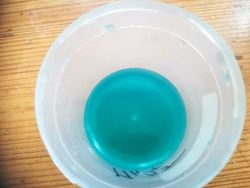Difference between revisions of "Hypomanganate"
| Line 144: | Line 144: | ||
:MnO<sub>4</sub><sup>2-</sup> + CH<sub>3</sub>-CH<sub>2</sub>-OH → MnO<sub>2</sub> + CH<sub>3</sub>-CHO + 2OH<sup>-</sup> | :MnO<sub>4</sub><sup>2-</sup> + CH<sub>3</sub>-CH<sub>2</sub>-OH → MnO<sub>2</sub> + CH<sub>3</sub>-CHO + 2OH<sup>-</sup> | ||
| − | [[File:Reduction of ethanol by hypomanganate.png| | + | [[File:Reduction of ethanol by hypomanganate.png|1120px|thumb|left|Oxidation of ethanol by hypomanganate in hot water bath. From left: 1. Beginning of the reaction; 2. Disproportionation; 3. Reduction of manganate in to MnO<sub>2</sub>.nH<sub>2</sub>O]] |
Hypomanganates can be oxidized by [[permanganate]]s in to [[manganate]]s: | Hypomanganates can be oxidized by [[permanganate]]s in to [[manganate]]s: | ||
Revision as of 00:33, 12 February 2020
 Hypomanganate solution in 40% NaOH
| |
| Names | |
|---|---|
| IUPAC name
Hypomanganate
| |
| Other names
Manganate(V)
| |
| Properties | |
| MnO43- | |
| Molar mass | 118.934 g/mol |
| Appearance | Turquoise solid |
| Disproportionate in to hydrated manganese dioxide and permanganate | |
| Solubility | Soluble in cold concentrated solutions of alkali metal hydroxides |
| Acidity (pKa) | 13.7 ± 0.2 |
| Related compounds | |
| Related compounds
|
Manganese dioxide Manganate Permanganate |
| Except where otherwise noted, data are given for materials in their standard state (at 25 °C [77 °F], 100 kPa). | |
| Infobox references | |
Hypomanganate is the name for the anion containing manganese in V oxidation state. This anion have formula MnO43-. It have intense turquoise colour.
Contents
Structure
Hypomanganate anion consist of one manganese atom surrounded with four oxygen atoms in a tetrahedral arrangement.
Properties
Solutions of hypomanganates are stable only in very strongly alkaline conditions at lower temperatures (0-15°C). In less alkaline solutions or at higher temperatures they decompose in to manganate and hydrated manganese dioxide:
- MnO43- + H2O → HMnO42- + OH-
- 2HMnO42- → MnO42- + MnO2 + 2OH-
In neutral or acidic solutions disproportionation goes further in to hydrated manganese dioxide and permanganate:
- 2MnO42- + 4H3O+ → MnO2 + MnO4- + 6H2O
Hypomanganates are mild oxidizing agents. They can oxidize hydrogen peroxide in to oxygen:
- 2MnO43- + H2O2 + 2H2O → 2MnO2 + O2 + 6OH-
They are also reduced by sodium dithionite:
- 2MnO43- + S2O42- + 2H2O → 2MnO2 + 2SO32- + 4OH-
They can oxidize certain organic compounds such sucrose, tartaric acid, ascorbic acid or sorbitol, while they are reduced in to hydrated manganese dioxide.
They can oxidize glucose and fructose as well, but with different course of reaction. Firstly is hypomanganate reduced in to hydrated manganese dioxide. If it’s sugar in excess then reduction goes further in to Mn2+. In this case are Mn2+ ions present as colourless complex with glucose or fructose which is in excess of reagent stable against aerial oxidation (sugar prevents oxidation of Mn(II) in to Mn(III)). At the surface of solution can be observe brown ring which indicates oxidation by atmospheric oxygen. After swirling of the solution brown ring disappear for a while. Reduction by glucose is much slower than reduction by fructose.
Cold solutions doesn’t react with ethanol. However hot solutions can oxidize it. This is caused by disproportionation of hypomanganate in to manganate which have better oxidation properties:
- MnO42- + CH3-CH2-OH → MnO2 + CH3-CHO + 2OH-
Hypomanganates can be oxidized by permanganates in to manganates:
- MnO43- + MnO4- → 2MnO42-
Solid hypomanganates are stable up to 900°C.
Preparation
Solutions of hypomanganates can be prepare by reduction of potassium permanganate by sodium thiosulfate, sodium sulfite, potassium iodide, sodium tartrate or acetone in 40% NaOH at 0-5°C. Reducing agent should be add as a solid or concentrated solution in 20% NaOH to avoid dilution of 40% NaOH medium.
Reaction have two steps. First step is quick reduction of permanganate in to green manganate:
- 8MnO4- + S2O32- + 10OH- → 8MnO42- + 2SO42- + 5H2O
Second step is slow reduction of manganate in to turquoise hypomanganate. This reaction lasts about half an hour:
- 8MnO42- + S2O32- + 10OH- → 8MnO43- + 2SO42- + 5H2O
From these solutions can be precipitate barium hypomanganate by addition of solution of barium salt:
- Ba2+ + MnO43- → Ba3(MnO4)2 ↓
Solid hypomanganates can be prepare by heating manganese dioxide with sodium nitrite and sodium hydroxide:
- MnO2 + NaNO2 + 2NaOH → Na3MnO4 + NO + H2O
Another method is oxidation of manganese dioxide by dry air in molten sodium or potassium hydroxide:
- 4MnO2 + O2 + 12KOH → 4K3MnO4 + 6H2O
Similar preparation is heating of manganese(II) carbonate with potassium carbonate in the presence of dry air:
- 4MnCO3 + 3O2 + 6K2CO3 → 4K3MnO4 + 10CO2
Barium hypomanganate can be also make by heating of any manganese oxide with excess of barium oxide at 900°C:
- 4MnO2 + O2 + 6BaO → 2Ba3(MnO4)2
Projects
- Making barium hypomanganate
Handling
Safety
Hypomanganates are oxidizing agents. They should be kept away from reducing agents and combustible materials.
Hypomanganates are harmful if ingested.
Solutions of hypomanganates are very corrosive because they contain high concentration of hydroxide. When working with it, gloves and goggles should be weared.
Hypomanganates can‘t be mixed with concentrated sulfuric acid because of formation of unstable and explosive manganese heptoxide.
Storage
Solutions should be stored in fridge with excess of reducing agent (preferably under a inert atmosphere, but it isn't necessary). In these conditions they are relatively stable.
Solids should be stored in desiccator because moisture and CO2 cause disproportionation.
Disposal
Small amount of dilute solution can be poured in to the drain with lot of water. Larger amounts can be dilute, neutralized with acid and reduced by reducing agent in to hydrated manganese dioxide, which can be filtred off and brought in to municipal waste processing facility.
References
- Personal experience with handling and investigating hypomanganates by forum user Bedlasky
- Heinrich Remy - Inorganic chemistry
